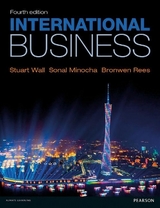
International Business
Financial Times Prentice Hall (Verlag)
978-0-273-72372-1 (ISBN)
- Titel erscheint in neuer Auflage
- Artikel merken
It explains in straightforward language the economic and financial underpinnings of international trade, the more subtle organisational and cultural issues, and the managerial challenges which face organisations of all types and sizes. In particular, it provides up-to-the-minute coverage of recent global events the economic downturn and uncertainty in financial markets.
It is written for students on undergraduate and postgraduate degree programmes, or undertaking professional qualifications. It is especially suitable for non-specialist students of business.
Stuart Wall is Head of Department at the Ashcroft International Business School, Anglia Ruskin University in Cambridge. Sonal Minocha and Bronwen Rees are both also at Anglia Ruskin University.
Preface: using this book xiii
Acknowledgements xiv
Abbreviations xvii
1 Introduction to international business
Introduction
Patterns and trends in international business
Globalisation
The multinational enterprise (MNE)
How important are the multinationals?
Useful websites
Useful key texts
Other texts and sources
Case studies
1.1 Dyson relocates production to South-East Asia
1.2 Happy birthday, globalisation
1.3 How to play the home advantage
1.4 Does a global approach benefit the company?
1.5 Competing in a globalised economy
Boxes
1.1 Relative Unit Labour Costs (RULC)
1.2 Definitions of Globalisation
1.3 Globalisation Features
2 Internationalisation process
Introduction
Export-based methods for internationalisation
Non-equity-based methods for internationalisation
Equity-based methods for internationalisation
Why invest abroad?
Theoretical explanations
Useful websites
Useful key texts
Other texts and sources
Case studies
2.1 Helping inward fdi
(a) South Africa: Skills Support Programme
(b) Egypt: Suppliers Development Programme
2.2 Patents and the EU pharmaceuticals market
2.3 Legal Process Outsourcing in India
2.4 Market entry into China
2.5 The Japanese keiretsu
2.6 China versus South Korea
2.7 Toyota wins support for its US operations
2.8 Daewoo moves into international agriculture
2.9 Internationalisation may not always deliver!
Boxes
2.1 'Flat tax' regimes
2.2 Government policies, exporting and fdi
3 International business: theory and practice
Introduction
Gains from trade
Sources of comparative and competitive advantage
Trade and the world economy
Barriers to trade
Protectionist policies
Regional trading arrangements
Government policies and international business
International institutions and world trade
The European Union (EU)
Useful websites
Useful key texts
Other texts and sources
Case studies
3.1Impacts of freer trade
3.2 Intra-industry trade: Honda
3.3 High cost of anti-dumping tariffs
3.4 Harbours of resentment
3.5 WTO to rule on US import duties
Boxes
3.1 Comparative advantage and opportunity cost
3.2 Gains from trade
3.3 Impacts of a tariff
3.4 Impacts of a subsidy
3.5 Customs Union: trade creation and trade diversion
3.6 Impacts of EU policies on farms and agri-businesses
3.7 IMF stabilisation programmes
3.8 World Bank structural adjustment and stabilisation
4 The political, legal, economic and technological environment
Introduction
Political environment
Political risk
The international legal environment
Intellectual property rights
Economic systems
Economic variables and the business environment
Technological environment
Technology transfer
Useful websites
Useful key texts
Other texts and sources
Case studies
4.1 Chinese government and EU milk products
4.2 BMW after Rover
4.3 Tougher scrutiny of foreign takeovers in US
4.4 Intellectual Property Rights (IPR) in India: Novartis
4.5 Extending copyright
4.5 Intellectual property rights in China (IPR): Durex
4.6 Market influences on Wellcome share price
4.7 China's capital markets begin to open
4.8 Finance chiefs take pessimistic view
Boxes
4.1 EU directives and state aid
4.2 EU directives and data protection
4.3 Strategic patenting
4.4 Elasticity of demand
4.5 Creating or destroying jobs
5 International sociocultural environment 171
Introduction
National cultural characteristics
Cultural impacts on international business
National, organisational and occupational cultures
Strategies for developing intercultural competence
Useful websites
Useful key texts
Other texts and sources
Case studies
5.1 National culture and Japanese competitiveness
5.2 East meets West
5.3 Culture of communication breaks through traditional barriers
5.4 Corporate culture and Japanese competitiveness
5.5 Management gurus might rethink the Dutch approach
5.6 Challenges to cross-cultural team management
5.7 Corporate 'personality' has a big impact on business success
Boxes
5.1 A clash of cultures
5.2 National and organisational cultural dimensions
6 International ethical and ecological environment
Introduction
Business ethics
Ethics and the corporate culture
Different ethical positions
International business ethics
International efforts to improve business ethics
Ecological/environmental issues
Global warming, 'carbon footprint' and tradable permits
Useful websites
Useful key texts
Other texts and sources
Case studies
6.1 The Body Shop
6.2 Ethics and profits
6.3 Bribery and international business
6.4 US groups in ethical standards push
6.5 Taxing and regulating smoking
6.6 Organic farming
6.7 Biofuels subsidies criticised
6.8 Prices no incentive for a clean up
Boxes
6.1 An ethical dilemma
6.2 TI Corruption Perception Index
6.3 Environmental impacts, taxes and regulations
6.4 Stern Report and global warming
6.5 The EU Emissions Trading Scheme
7 International strategic issues
Introduction
Business strategy ideas and concepts
Choice of strategy
Corporate strategy in a global economy
International business and the value chain
International business strategies
International business strategies and political perspectives
Institutional strategies and international business
Techniques for strategic analysis
International operations management and logistical strategies
Useful websites
Useful key texts
Other texts and sources
Case studies
7.1 Strategies in practice
a) Pharmaceutical sector
b) Brewing
7.2 Strategic mistakes at Citibank
7.3 MNE strategies in the US market
7.4 US carmaking: political and economic imperatives
7.5 Daimler-Benz AG and Chrysler
7.6 Telematics and strategic choice
7.7 Game theory in action: designing the US airwaves auction
7.8 Strategic scenario analysis: AMD versus Intel
7.9 Operations management system: Khan Handicrafts
Boxes
7.1 Mergers and acquisitions incentives
7.2 Two-firm zero-sum game
7.3 Lean production
7.4 Inventory (stock) costs and control
7.5 Economies of scope and the transport sector
8 International human resource management
Introduction
Human resource management function
International human resource management (IHRM)
International HRM approaches
IHRM policies and practices
Work practice in an international context
Useful websites
Useful key texts
Other texts and sources
Case studies
8.1 HRM and the external environment
8.2 Islamic culture and IHRM
8.3 Mindset of a Toyota manager revealed
8.4 Reward mechanisms in cross-cultural contexts
8.5 IHRM and national cultures
Boxes
8.1 Greek national culture and decentralisation of the IHRM function
9 International marketing
Introduction
The principal activities of marketing
International marketing
Decision-making and international marketing
Market selection
Market-entry strategies
International marketing mix
International marketing planning
Useful websites
Useful key texts
Other texts and sources
Case studies
9.1 Global rebranding of BP
9.2 A better burger thanks to data crunching
9.3 Variations in the international marketing mix
9.4 India's new affluent consumers
9.5 Global brands
9.6 Lessons for marketers who face a hard sell
9.7 Love in a cold climate
9.8 Indian stores in search of drama
Boxes
9.1 Market segmentation
9.2 Strategic pricing initiatives
9.3 Price elasticity of demand (PED) and revenue
9.4 Price discrimination
9.5 Promotion / advertising and demand
9.6 UK internet trends in 2007/8
10 International finance: theory and practice
Introduction
The background to accounting
Major financial accounting statements
The profit and loss account (or 'Statement of Income')
The balance sheet
The cash-flow statement
Published accounts
Differences of approach in different countries
Global accounting standards
Corporate governance and international business
International financial management
Useful websites
Useful key texts
Other texts and sources 8
Case studies
10.1 SIV managers dig out their manuals
10.2 Seniority brings a false sense of security
10.3 Sum of the parts
10.4 Spate of downgrades raises fears
10.5 Risk needs a human touch
10.6 'To converge to a single set of standards is now crucial'
Boxes
10.1 Types of exchange rate
10.2 Structured Investment Vehicle (SIV)
10.3 Financial instruments and international trade
10.4 Sarbanes-Oxley Act 2002
Answers and responses
Index
| Verlagsort | Harlow |
|---|---|
| Sprache | englisch |
| Maße | 191 x 244 mm |
| Gewicht | 920 g |
| Themenwelt | Wirtschaft ► Betriebswirtschaft / Management ► Unternehmensführung / Management |
| ISBN-10 | 0-273-72372-3 / 0273723723 |
| ISBN-13 | 978-0-273-72372-1 / 9780273723721 |
| Zustand | Neuware |
| Haben Sie eine Frage zum Produkt? |
aus dem Bereich



